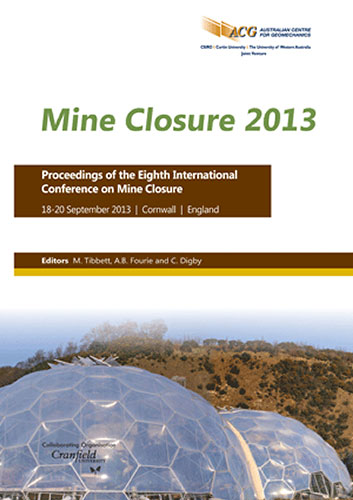Closure of uranium tailings facilities: environmental considerations, regulatory framework and conceptual options

|
Authors: Gunsinger, MR; Andruchow, B; Becker, E |
DOI https://doi.org/10.36487/ACG_rep/1352_13_Gunsinger
Cite As:
Gunsinger, MR, Andruchow, B & Becker, E 2013, 'Closure of uranium tailings facilities: environmental considerations, regulatory framework and conceptual options', in M Tibbett, AB Fourie & C Digby (eds), Mine Closure 2013: Proceedings of the Eighth International Seminar on Mine Closure, Australian Centre for Geomechanics, Cornwall, pp. 149-157, https://doi.org/10.36487/ACG_rep/1352_13_Gunsinger
Abstract:
Uranium tailings are the residues that remain after uranium has been extracted and concentrated from ore materials. By virtue of the ore-rock mineralogy, and the beneficiation and concentration processes, the extraction of uranium from the ore material is not completely efficient, resulting in concentrations of uranium in the tailings that often exceed the background concentrations in the surrounding native materials. In addition, the other radionuclides in uranium-238 decay chain are of no commercial use and are shunted to the tailings circuit. Depending on solubility characteristics, the residual radionuclides in the tailings can become mobilised, potentially degrading the quality of nearby surface water and groundwater to levels deemed unacceptable by local regulations. In addition, the presence of uranium-decay series radionuclides constitutes a source of ionising radiation and gaseous radon, which can result in the exposure of receptors to radiation doses greater than regulatory limits. As such, uranium tailings represent high-volume, low-level radioactive wastes that require special management and closure considerations. Before evaluating potential closure or rehabilitation strategies for tailings management facilities, the technical aspects and the risks associated with the tailings need to be well understood. In regard to the environmental risks associated with uranium tailings, the potential sources, pathways and receptors of radiation and radioactive substances require special consideration. Local governing policies, acts and regulations need to be considered, which will provide the regulatory framework and in some cases the criteria with which the closure activities need to comply. In the case of low-level radioactive waste, such as uranium tailings, particular consideration needs to be given to relevant radiation protection standards and guidelines. Along with the local regulation, the characteristics of the source-term, receptor exposure pathways and related human and ecological health risks will largely govern the appropriate mitigation strategies. Closure strategies for uranium tailings may include the implementation of a combination of engineered-control measures to reduce the contaminate source, immobilise or isolate contaminates within a defined area or reduce the flux of contaminates through a specific-exposure pathway. In many cases, the selected closure option for uraniferous tailings will need to include a combination of strategies to mitigate impacts due to radionuclide leaching, emanation of ionising radiation and release of radon gas. This paper provides an overview of the environmental considerations, regulatory framework and conceptual options for the closure of uranium tailings facilities. Neutralisation of tailings solids and process water can also result in the precipitation of secondary iron minerals. Widespread examples of secondary iron minerals in tailings include ferric oxyhydroxides (e.g., goethite [αFeO(OH)]) and ferric hydroxysulphates (e.g., jarosite [KFe3(SO4)2(OH)6]) (Blowes et al., 2004):
References:
Blowes, D.W., Ptacek, C.J., Jambor, J.L. and Weisner, C.G. (2004) The geochemistry of mine drainage, in B.S. Lollar, H.D. Holland and K.K. Turekian (eds), Treatise on Geochemistry, Environmental Geochemistry, Vol. 9, pp. 149–204.
Bryan, C.R. and Siegel, M.D. (2004) Environmental geochemistry of radioactive contamination, in B.S. Lollar, H.D. Holland and K.K. Turekian (eds), Treatise on Geochemistry, Environmental Geochemistry, Vol. 9, pp. 205–262.
Construction Industry Research and Information Association (2004) Safegrounds – Technical Options for Managing Contaminated Land, H. Mallet (ed), Classic House, London.
DeWindt, L., Burnol, A., Montarnal, P. and Van der Lee, J. (2003) Intercomparison of reactive transport models applied to UO2 oxidative dissolution and uranium migration, Journal of Contaminant Hydrology, Vol. 61, p. 303.
Fuller, C.C., Piana, M.J., Bargar, J.R., Davis, J.A. and Kohler, M. (2002) Evaluation of apatite materials for use in permeable reactive barriers for the remediation of uranium-contaminated groundwater, in Handbook of Groundwater Remediation Using Permeable Reactive Barriers—Applications to Radionuclides, Trace Metals, and Nutrients, D.L. Naftz, S.J. Morrison, J.A. Davis and C.C. Fuller (eds), Academic Press, San Diego, CA, pp. 255–280.
IAEA (International Atomic Energy Agency) (2002) Management of Radioactive Waste from the Mining and Milling of Ores, Vienna.
Nazaroff, W.W. (1992) Radon transport from soil to air, Review of Geophysics, Vol. 30(2), pp. 137–160.
Naftz, D.L., Fuller, C.C., Davis, J.A., Morrison, S.J., Feltcorn, E.M., Freethey, G.W., Rowland, R.C., Wilkowske, C. and Piana, M. (2002) Field demonstration of three permeable reactive barriers to control uranium contamination in groundwater, Fry Canyon, Utah, in Handbook of Groundwater Remediation Using Permeable Reactive Barriers—Applications to Radionuclides, Trace Metals, and Nutrients, D.L. Naftz, S.J. Morrison, J.A. Davis and C.C. Fuller (eds), Academic Press, San Diego, CA, pp. 401–434.
Pacific Northwest Laboratory (1984) An In Situ Vitrification Pilot – Scale Radioactive Test, C.L. Timmerman and K.H. Oma (eds), Washington.
Rogers, V.C., Nielson, K.K. and Kalwarf, D.R. (1984) Radon Attenuation Handbook for Uranium Mill Tailings Cover Design, prepared for U.S. Nuclear Regulatory Commission.
US NRC (Nuclear Regulatory Commission) (2013) Appendix A to Part 40—Criteria Relating to the Operation of Uranium Mills and the Disposition of Tailings or Wastes Produced by the Extraction or Concentration of Source Material From Ores Processed Primarily for Their Source Material Content, viewed 1 May 2013, .
US EPA (2000) Environmental Protection Agency. Field Demonstration of Permeable Reactive Barriers to Remove Dissolved Uranium from Groundwater, Fry Canyon, Utah, Washington.
© Copyright 2025, Australian Centre for Geomechanics (ACG), The University of Western Australia. All rights reserved.
View copyright/legal information
Please direct any queries or error reports to repository-acg@uwa.edu.au
View copyright/legal information
Please direct any queries or error reports to repository-acg@uwa.edu.au